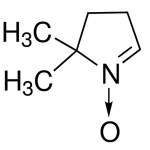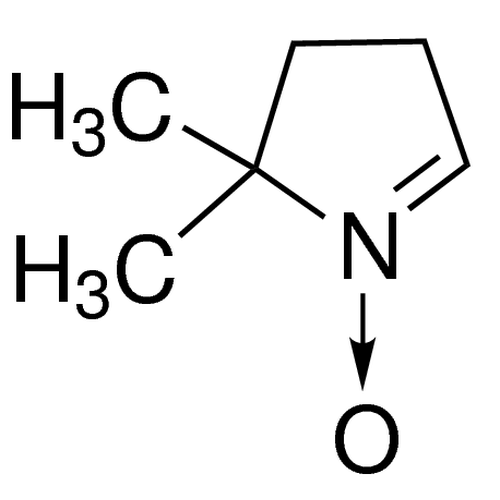| Product Name | DMPO |
| Description |
Spin trapping reagent |
| Purity | >98% |
| CAS No. | 3317-61-1 |
| Molecular Formula | C6H11NO |
| Molecular Weight | 113.16 |
| Field of Use | Not for use in humans. Not for use in diagnostics or therapeutics. For in vitro research use only. |
Properties
| Storage Temperature | -20ºC |
| Shipping Temperature | Shipped Ambient |
| Product Type | Agent, Small Molecules |
| Solubility | Soluble to 100 mM in ethanol and to 100 mM in DMSO |
| Source | Synthetic |
| Appearance | Liquid |
| SMILES | CC1(CCC=[N+]1[O-])C |
| InChI | InChI=1S/C6H11NO/c1-6(2)4-3-5-7(6)8/h5H,3-4H2,1-2H3 |
| InChIKey | VCUVETGKTILCLC-UHFFFAOYSA-N |
| Safety Phrases |
Classification: Harmful. May be harmful if inhaled, swallowed or absorbed through skin. Safety Phrases: S22 - Do not breathe dust S36/37/39 - Wear suitable protective clothing, gloves and eye/face protection S24/25- Avoid contact with shin and eyes |
| Cite This Product | DMPO (StressMarq Biosciences Inc., Victoria BC CANADA, Catalog # SIH-324) |
Biological Description
| Alternative Names | 2,2-Dimethyl-3,4-dihydro-2H-pyrrole 1-oxide, 5,5-Dimethyl-1-Pyrroline-N-Oxide, 3,4-dihydro-2,3-dimethyl-2H-pyrrole 1-oxide |
| Research Areas | Cancer, Oxidative Stress |
| PubChem ID | 1774 |
| Scientific Background | DMPO (5,5-dimethyl-1-pyrroline N-oxide) is a spin trap used to detect reactive oxygen species and free radicals in biological systems. Its low toxicity and favorable pharmacokinetics make it suitable for in vivo studies. DMPO adducts can be formed with protein and DNA radicals, aiding in the investigation of oxidative stress—a key contributor to neurodegenerative diseases. Caution is advised when interpreting results in the presence of nitric oxide due to potential interference. |
| References |
1. Reszka K.J., et al. (2006) Nitric Oxide 15: 133-141. 2. Ramirez D.C., Gomez-Mejiba S.E., and Mason R.P. (2007) Nat Protoc. 2(3): 512-522. 3. Khan N., et al. (2003) Free Radic. Biol. Med 34:1473–1481. 4. Haseloff R.F., et al. (1997) FEBS Lett 418:73–75. 5. Schaefer C.F., Janzen E.G., West M.S., Poyer J.L., and Kosanke S.D. (1996) Free Radic. Biol. Med 21:427–436. 6. Anzai K., et al. (2003) Arch. Biochem. Biophys 415:251–256. 7. Chatterjee S., Ehrenshaft, M., Bhattacharjee ,S., Derterding, L.J., Bonini, M.G., Corbett, J., Kadiiska, M.B., Tomer K.B. and Mason, R.P. 2009 Free Radic. Med. and Biol. 46:454-461. |



Reviews
There are no reviews yet.